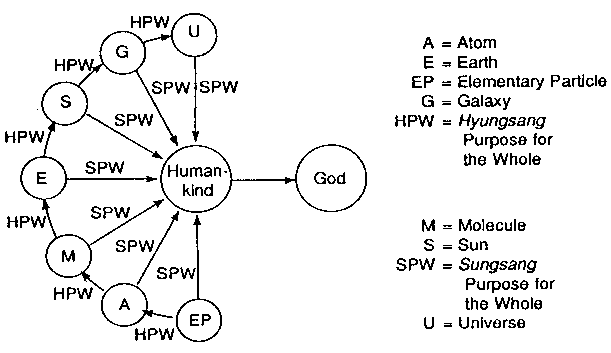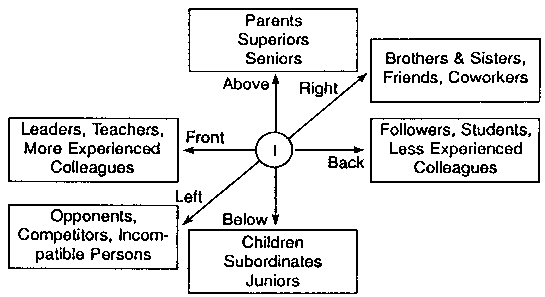
Essentials Of Unification Thought - The Head-Wing Thought

|
|
Essentials Of Unification Thought - The Head-Wing Thought |
|
IV. The Connected Body
The individual truth body contains within itself the correlative elements of subject and object centered on purpose, and these two elements are united through give-and-receive action. In addition to that, an individual truth body can also form a relationship of subject and object with another individual truth body, whereby the two can engage in give-and-receive action. When placed in such a relationship, the individual truth body is called a "connected body."
A. The Connected Body and the Dual Purpose of Existing Being
From the perspective of purpose, a connected body refers to an existing being with a dual purpose, namely, the "purpose for the individual" and the "purpose for the whole." The purpose for the individual is to maintain and develop its own existence as an individual being. The purpose for the whole is to contribute to the existence and the development of die whole.
For examples of dual purpose, let us consider the system of the created world, which extends from the level of elementary particles all the way to the level of the universe itself. Elementary particles exist for the purpose of forming atoms, but at the same time, they maintain their own existence as elementary particles. Atoms exist for the purpose of forming molecules, but at the same time, they maintain their own existence as atoms. Molecules exist for the purpose of forming cells, but at the same time they maintain their own existence as molecules. Cells exist for the purpose of forming tissues and organs, but at the same time they maintain their own existence as cells. Atoms and molecules also exist for the purpose of forming minerals, which form all material bodies, such as the earth. The earth exists for the purpose of forming the Solar system, but at the same time, it maintains its own existence as the earth. The Solar system exists for the purpose of forming the galaxy, but at the same time, it maintains its own existence as the solar system. The galaxy exists for the purpose of forming the universe, but at the same time, it maintains its own existence as the galaxy. Furthermore, the universe exists for the sake of humankind, but at the same time, it maintains its own existence as the universe.
In this way, all created beings have a dual purpose, namely, the purpose for the whole and the purpose for the individual. Among the various purposes for the whole, which one is the highest purpose? In the created world, the highest purpose is to exist for the sake of human beings. For human beings, the highest purpose is to exist for the sake of God. Thus, all created beings, from elementary particles to the universe and to human beings, exist as connected bodies with dual purpose.
Within the purpose for the whole, there are two types of purposes, namely the "Sungsang purpose for the whole" and the "Hyungsang purpose of the whole." For example, the earth has the purpose of forming the solar system, and at the same time it has the purpose of serving as the dwelling place for human beings. In the case of electrons, they revolve around the atomic nucleus in order to form an atom, and also they do so for human beings by forming all things, which exist for the sake of human beings, since things are objects of human dominion. Thus, each level of created beings from elementary particles to the universe itself -- exists both for the purpose of being part of a higher level being and, at the same time, for the sake of humankind. The former purpose is called the "Hyungsang purpose for the whole," and the latter purpose is called the "Sungsang purpose for the whole" (Fig. 2-4).

Fig. 2-4: The System of Purposes for the Whole in Created Beings
B. The Connected Body and the Original Image
We saw previously that the Original Image exists in a two-stage structure, namely, the Inner Four-Position Base and the Outer Four-Position Base. In the created world, all beings exist in a similar two-stage structure: they maintain inner four-position bases as individual truth bodies while forming outer four-position bases with other individual truth bodies.
In human beings, an inner four-position base is formed through give-and-receive action between the spirit mind and the physical mind, and an outer four-position base is formed through give-and-receive action with another person. Human beings must harmoniously maintain both their inner and their outer four position bases. In other words, the proper way of life is to live a life of values (forming inner four-position bases) and to love others (forming outer four-position bases).
In forming an outer four-position base, the human being enters into give-and-receive actions with other people in six directions, namely, above and below, front and back, and right and left. Taking oneself as the center, above there are one's parents, superiors, and seniors; below there are one's children, subordinates, and juniors; to the front, there are leaders, more experienced colleagues, and teachers; to the back, there are followers, less experienced colleagues, and students; to die right, there are brothers and sisters, friends, and coworkers; and to the left, there are opponents, competitors, and incompatible persons. The original way of life for human beings is to form harmonious relationships in all six directions (Fig. 2-5).

Fig. 2-5: The Six Directions of Human Relationships of a Connected Body
Human beings also stand in a relationship with the natural environment. They are susceptible even to the influence of the stars that is to say, it is commonly held that cosmic rays exert a certain influence on human physiological functions. Human beings have a close connection with minerals, plants, and animals. In this sense as well, the human being is a connected body.
C Materialistic Dialectic and Interconnectedness
In agreement with Unification Thought, materialistic dialectic asserts that all things in the universe are mutually interconnected.
Stalin, for instance, emphasized the interconnectedness of all things and branded as metaphysical the position of those who regard things as separate beings. He said, "Contrary to metaphysics, dialectics does not regard nature as an accidental agglomeration of things, of phenomena, unconnected with, isolated from, and independent from, each other, but as a connected and integral whole, in which things, phenomena, are organically connected with, dependent on, and determined by, each other." 9
From the perspective of Unification Thought, all beings are created in the resemblance of God's dual characteristics, and therefore they exist not only as individual truth bodies, but also as connected bodies, whereby they are connected, directly or indirectly, with other individual truth bodies. From this perspective, we regard the universe as a huge, organic body. Materialistic dialectic explains all this in terms of interconnectedness. Nevertheless, materialistic dialectic merely acknowledges the interconnectedness of all things; it offers no adequate explanation as to why things are interconnected.
In contrast, Unification Thought maintains that each thing is interconnected with other beings centering on a purpose. Interconnectedness is something inevitable because every being has a purpose for the whole and engages in give-and-receive action with other beings that share the same purpose for the whole. For things, the highest purpose for the whole (in Sungsang terms) is essentially to exist for the sake of humankind. From this perspective, the entire universe can be regarded as an immense, organic body consisting of innumerable individual beings, all of which are mutually interconnected.
In the previous discussion, we dealt with the "image of existence" of existing beings, namely, the individual truth body and the connected body. In the discussion that follows, we will deal with the ,'mode of existence" of existing beings.
Download entire page and pages related to it in ZIP format
Table of Contents
Information
Tparents Home